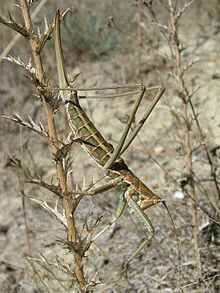| Saga pedo | |
|---|---|

| |
| Brown female in France | |
| Scientific classification | |
| Domain: | Eukaryota |
| Kingdom: | Animalia |
| Phylum: | Arthropoda |
| Class: | Insecta |
| Order: | Orthoptera |
| Suborder: | Ensifera |
| Family: | Tettigoniidae |
| Genus: | Saga |
| Species: | S. pedo
|
| Binomial name | |
| Saga pedo (Pallas, 1771)
| |
Saga pedo is a species of wingless bush cricket from the southern half of Europe and western and central Asia. This brown or green bush cricket typically has a total length, from the head to the tip of the ovipositor, of up to 10.5 cm (4.1 in),[3] but exceptionally it may reach 12 cm (4.7 in), which makes it one of the largest European insects[1][4] and one of the world's largest Orthoptera (grasshoppers, crickets and alike).[5] The head-and-body alone typically is 5–7 cm (2.0–2.8 in) long in adults,[3][6] but may reach up to 7.8 cm (3.1 in).[7][8]
Colloquially known as the predatory bush cricket, or the spiked magician (due to the "enchanting" manner in which it waves its forelimbs as it approaches its prey),[9] it is unusual due to its strictly carnivorous lifestyle and its parthenogenetic reproduction (only females exist and they breed by themselves).[10]
- ^ a b Orthopteroid Specialist Group (1996). "Saga pedo". IUCN Red List of Threatened Species. 1996: e.T19811A9018679. doi:10.2305/IUCN.UK.1996.RLTS.T19811A9018679.en. Retrieved 17 November 2021.
- ^ Cite error: The named reference
IUCN Europewas invoked but never defined (see the help page). - ^ a b Krištín, A.; Kaňuch, P. (2007). "Population, ecology and morphology of Saga pedo (Orthoptera: Tettigoniidae) at the northern limit of its distribution". Eur. J. Entomol. 104 (1): 73–79. doi:10.14411/eje.2007.012.
- ^ Rosa, M.P. (2021). "Primer registro de Saga pedo (Pallas, 1771) (Orthoptera: Tettigoniidae) para la provincia de Guadalajara (centro de la península ibérica)". Boletín de la S.E.A. 69: 246–248.
- ^ Flindt, R. (2006). Amazing Numbers in Biology. Springer. p. 10. ISBN 978-3-540-30146-2.
- ^ Holuša, J.; Kočárek, P.; Vlk, R. (2013). "Monitoring and conservation of Saga pedo (Orthoptera: Tettigoniidae) in an isolated nothwestern [sic] population". Journal of Insect Conservation. 17 (4): 663–669. doi:10.1007/s10841-013-9550-3. S2CID 254604098.
- ^ Schall, A. (2002). "Détails sur la connaissance de Saga pedo (Pallas, 1771), cycle biologique en captivité (Orthoptera, Tettigoniidae, Saginae)". Bulletin de la Société Entomologique de France. 107 (2): 157–164. Bibcode:2002AnSEF.107..157S. doi:10.3406/bsef.2002.16830. S2CID 89468594.
- ^ Lemonnier-Darcemont, M.; Bernier, C.; Darcemont, C. (2009). "Field and breeding data on the European species of the genus Saga (Orthoptera: Tettigoniidae)". Articulata. 24 (1/2): 1–14.
- ^ Blondel, J., Aronson, J., Bodiou, J-Y. and Boeuf, G. (2010) The Mediterranean Region. Biological Diversity in Space and Time. Third Edition. Oxford University Press, Oxford
- ^ Van Helsdingen, P.J.; Willemse, L.; Speight, M.C.D., eds. (1996). "Saga pedo (Pallas, 1771)". Background information on invertebrates of the Habitats Directive and the Bern Convention. Part II - Mantodea, Odonata, Orthoptera and Arachnida. Council of Europe. pp. 383–387.

